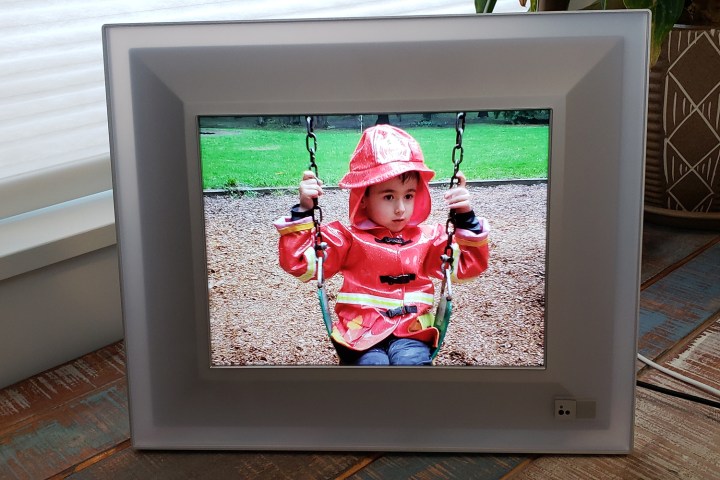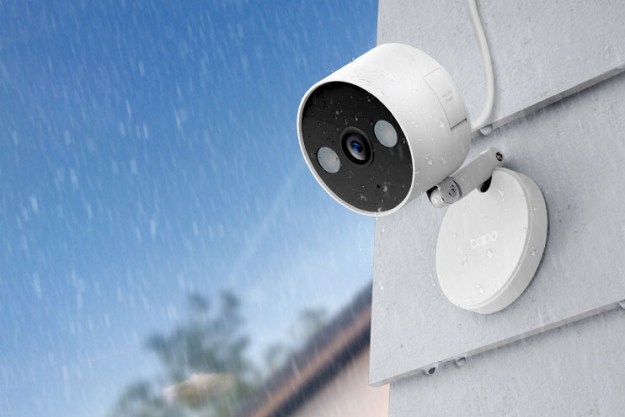
Are you one of those people who loves to take pictures, but miss the old days of displaying images in photo albums or frames? Some of us at Digital Trends really, REALLY miss those times (read: me). So when we got the chance to test out Aura ($299), the digital photo frame that connects to our phone and automatically rotates our favorite photos, we jumped at the chance.
While it doesn’t take the place of old-school photo albums, it is better in many ways. Rather than having one static photo in a frame, you can display thousands of pics. It’s also a beautiful device that automates the photo-framing experience in ways we never dreamed. We’ve had the frame sitting on a desk in our test office for a week or so now and can’t stop staring at it.
Gorgeous frame, great pics
The Aura digital frame is available in classic or modern styles. You can choose from ivory, sandstone, or charcoal in the classic style, or slate or stardust in the modern style. The frame itself is well-made, and the screen — a 9.7 inch, 2048 x 1536-pixel display — makes your pics really pop once they’re added to the screen. Unlike dumb, old photo frames, this smart device must be plugged in.

We opened the box to find a fancy-looking, heavy-duty frame in classic sandstone, along with a card with setup instructions, a power cord that resembles a shoelace on a fancy pair of shoes, and the back bracket. There are also mounting tools to hang the device on the wall if you choose.
Getting the Aura set up is seriously simple: Download the Aura app (for iOS or Android), then follow instructions for connecting the frame via Wi-Fi and Bluetooth. Once those steps are taken, you can get to the fun part: Adding photos to display on the frame. The app draws from the most obvious place first: The camera roll on your phone. You can choose which photos to add by hitting the plus sign. Depending on how long your camera roll is, it might take awhile to scroll through to find the treasures. The photos start to display on the screen immediately, and you can change the frequency of how often they rotate, ranging from seconds to hours. You can also crop the view on images via the app.
We kept our app open next to the frame and when we saw an image that looked blurry, we tapped on the app to hide it from the rotation. You can also remove it entirely be going into the settings. We found that we could use our phone as a remote control, forwarding images faster than we’d set them up to rotate just to see how they looked. It was a lot of fun. The images from our Samsung Galaxy S9 phone popped on the screen, giving us a brilliant, beautiful way to display images that might never see the light of day otherwise.

Gesture control and storage
The first thing we wondered about when we got the Aura up and running was about cloud storage. As in, how much of it do we have? After all, images suck up a lot of space. We’re happy to report that Aura has unlimited cloud storage for your photos, which means that you can feature an endless number of digital photos on your Aura and sort them like music playlists. Endless storage is pretty generous considering that most platforms often give you a hard cap on storage and make you pay for more.
The Aura also has something else that’s interesting: Gesture control. You read that right. On the bottom right-hand corner of the frame, there’s a motion sensor, and moving your hand in front of it will “swipe” the image to the next one in the queue. You can also “swipe” back if you wish. While gesture control is often iffy with other devices, we found that it works fine on the Aura about 75 percent of the time.
One final interesting feature of the Aura is that you can add friends to your frame, who can then — you guessed it — add their pictures to the device. So if you wanted to have images from grandparents or significant others’ collections rotating on the frame, just add them as friends in the app.

The verdict: Thumbs up
There’s so much to love about the Aura digital frame, but there are a couple of things that make us pause. First is the cost. At $299, it’s the perfect gift for grandma, but it’ll definitely cost you. With that said, the quality look of the frame, the unlimited photo storage, and the ability to add friends’ and loved ones’ photos makes the cost seem a little more reasonable. Plus, if you factor in the cost of having multiple photos printed and professionally framed, you’ll soon realize the value in the device.
The second thing that we were frustrated by is the app often had to be refreshed after selecting a new photo to view. It’s a small gripe, to be sure, but sometimes kept us from feeling like we could use our phone as a real-time remote control for the frame.
Overall, though, the Aura is a great, albeit expensive, gift for the photo lovers in your life. And we’re not the only ones who recommend it: Oprah Winfrey just named it to her 2018 list of favorite things.
Editors' Recommendations
- How $80 of photo processing software magically saved me thousands
- Amazon drops the price on these Nixplay digital picture frames for Mother’s Day


